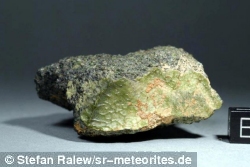
April Editorial
A one-of-a kind Meteorite

April Editorial
A one-of-a kind Meteorite
|
|
Meteorites are rare finds, but a recent discovery is for the moment unique. Most meteorites found on Earth are from the asteroid belt - a smaller number come from the moon or Mars, but these are rare. A green rock found in the southern deserts of Morocco in 2012 is not just rare but one of a kind. Officially numbered Northwest Africa [NWA] 7325, this is the very first meteorite which scientists believe to have come from the planet Mercury. |
|
|
NWA 7325 actually arrived on Earth as part of a group of 35 meteorites. In total this cluster weighs 345 grams and the components are believed to all be part of the same original meteorite. All the NWA 7325 fragments were discovered on sale in a moroccan market and were purchased by meteorite dealer Stefan Ralew. Samples of the strange-looking stone were sent to Anthony Irving, a meteorite specialist at the University of Washington. The chemical and dating analysis showed that the specimens were extremely old - in fact they were approximately 4.56 billion years old. Nor was this the only exceptional discovery, for the sample contained a chemical structure which did not fit the usual chemistry of known meteorites. According to Anthony Irving, NWA 7325 is an igneous achondrite with a partial chartreuse-colored fusion crust. An achondrite is stone meteorite that does not contain chondrules (the round grains found in chondrites). Achondrites constitute about 8% of known meteorites. Chartreuse is a colour halfway between yellow and green that was so named because of its resemblance to the green colour of one of the French liqueurs called green chartreuse. Although achondrites are not particularly rare or unique, the stones analysed by Irving also had the lowest magnetic intensity of any meteorite yet found; and in fact there were unusually low levels of iron. On the other hand, the investigating scientists found considerable amounts of magnesium, aluminum, and calcium silicates. This created some excitement, for the ratio of aluminium to silica and magnesium to silica and the low level of iron is consistent with what is known about the chemistry of rocks on Mercury’s surface. At least so says the data sent back by NASA's MErcury Surface, Space ENvironment,GEochemistry, and Ranging (MESSENGER) orbiter. One of the interesting discoveries which came from the MESSENGER data was the apparent lack of iron on Mercury. However the same data told scientists that the ratio of calcium to silica of 0.582 is too high for the meteorite to have originated from the surface of Mercury. The fact that the meteorite samples also have a distinctive 'frosty' luster of plagioclase (a series of minerals within the feldspar family) suggest that NWA 7325 originated from a deeper part of Mercury’s crust. Irving postulates that the meteor formed as "scum" on top of a magma field and was ejected by either a volcanic explosion or an impact from another space object striking Mercury. A volcano would agree with NASA’s MESSENGER data which showed volcanoes to be plentiful on the planet’s rocky crust. The extreme age of the meteorite has caused further controversy, as some experts argue that a rock that old could not have survived without considerable damage (brecciation) from other rocks. Although the Moon and Mars are closer and better sources of meteorites than Mercury, nothing of comparable age from either has ever been discovered on Earth. A critical test will soon tell more about the meteorite's origins. If this test shows that the rock has high levels of cosmogenic radionuclides (unstable atoms generated by exposure to cosmic radiation) this would indicate that it came from somewhere close to the sun - i.e. Mercury. However, if the test shows low levels of cosmogenic radionuclides this will raise the question of where else the rock could have come from. Achondrites come only from celestial bodies large enough to have generated internal heat, so if the stone did not come from Mercury, this raises the question of what other bodies in the solar system (or beyond?) might have that same rare chemical composition. One thing scientists do know for certain. The green colouration of the rock is due to the fact that several thousand parts per million are composed of chromium. So the rock is green for the same reason that some wine bottles are. A detailed description of NWA 7325 has been presented by Irving at the 44th Lunar and Planetary Science Conference last month. You can see the full transcript of his presentation in the reference below. Journal Reference:
| |
| _______________________________ | ||||
| Home | | | Shopping | | | Database |
© Biscuit Software 2004-2015
All rights reserved